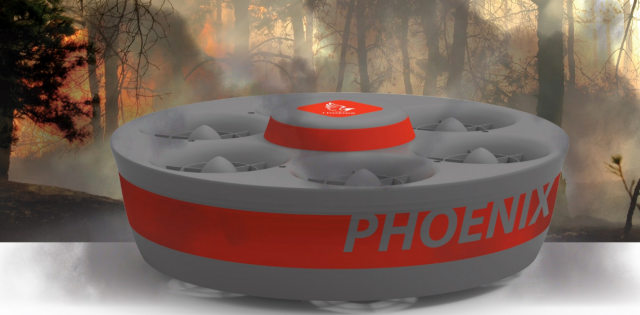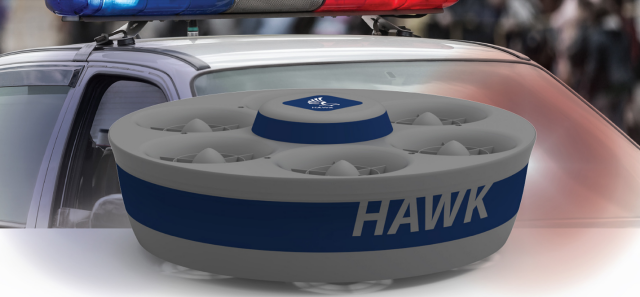The new Hexpuck UAS by Ashima Devices are launched by hand and recovered by hand. You just press the “come back” button on your touch screen pad and it comes back. “It’s not something like you set on the ground and it has little legs on it,” said Larry Lambert, Ashima co-founder and vice president. “It’s like a flying saucer.
A small flying saucer. Current models are 12 inches in diameter, and the company — which just announced that it’s relocating its headquarters to Reno — is designing new ones that are two-thirds that size.
“Instead of having external blades that spin like a helicopter, we have six internal, electrically powered, ducted fan jet motors that propel the vehicle,” Lambert said.
It does not have wings. It hovers. The intention behind its design was to provide situational awareness — knowing what’s going on around you — for first responders such as fire and police, as well as for industrial situations.
“The craft can operate in very harsh environments or ones that are dangerous to people, such as inside ballast tanks of ships to survey metal fatigue,” he said.
“We came up with a simple system. Every time you see one of these (drone) things, somebody has to fly it and that’s a bad idea because you’ve got to have your hands free if you’re a soldier, a policeman, a fireman.
“If you’re on an oil rig and need to see what’s on the other side of whatever you’re clinging to, you want three or four points of contact so the idea was to have something that’s semi-autonomous and would move with the user and would be operated basically on an Android pad you could wear on your wrist — or you can hold it, it’s up to you — that has preset flight characteristics with the ability for you to move it and nudge and fly it as much as necessary but it’s a one finger move.”
Drones that have open blades can’t fly through trees, fly through buildings or bump against walls because if they hit anything, they’re dead.
“With ours, that doesn’t matter because it’s all contained,” Lambert said.
 “We have patented acoustic sensors that can fly through a building. If it’s a fire department, it can map the inside of a smoky building by using acoustics so you can see if somebody’s down. It’s the same way in a very dark environment like a ship’s ballast. (The device) doesn’t need to see where it’s going optically. It will begin to map everything within that space automatically and use sensors we’re developing to find, detect and evaluate metal fatigue stress cracks.”
“We have patented acoustic sensors that can fly through a building. If it’s a fire department, it can map the inside of a smoky building by using acoustics so you can see if somebody’s down. It’s the same way in a very dark environment like a ship’s ballast. (The device) doesn’t need to see where it’s going optically. It will begin to map everything within that space automatically and use sensors we’re developing to find, detect and evaluate metal fatigue stress cracks.”
Lambert gave the example of a police officer on a traffic stop and said the device has presets for a “traffic stop 1” when the stop is routine and “traffic stop 2” when there’s an extra element of risk.
“These things operate automatically, you just pull it out and toss it in the air and it starts,” he said. “If you hit traffic stop 1, it’ll go forward 10 meters and out 10 meters and sit there and hover and you can look through the windshield of the car you’re stopping. They’ll see it and you’ll see it but you’ll have your hands free as you walk up to the car. If you need to nudge it left or right before you walk up so it’s in the right place, you can do that.”
The devices are loud so everyone knows a drone is in use.
“We could’ve made them more quiet,” Lambert said. “We left them loud for a purpose. We don’t want people to sneak up and peer through your window without you knowing about it. It was a conscious decision to keep them loud because if the police are going to walk through your yard and they’re allowed to be there, loud is not an issue. You know the cops are coming. This is not a stealth device.
“We care deeply about Fourth Amendment issues and we care deeply about public safety. And we care deeply about blending those so the public feels safer and that their rights aren’t being violated.”
Source: Reno Gazettte

